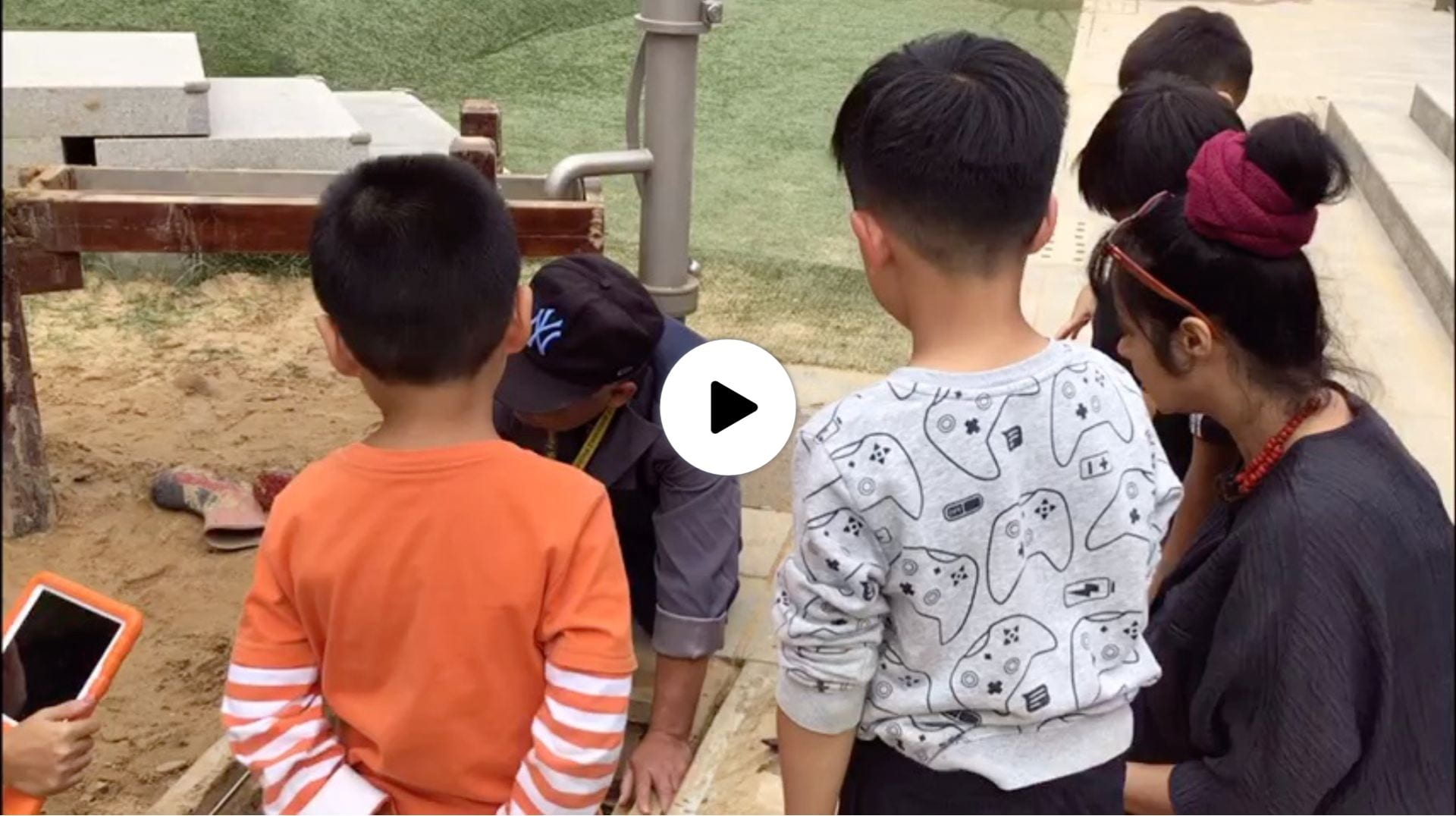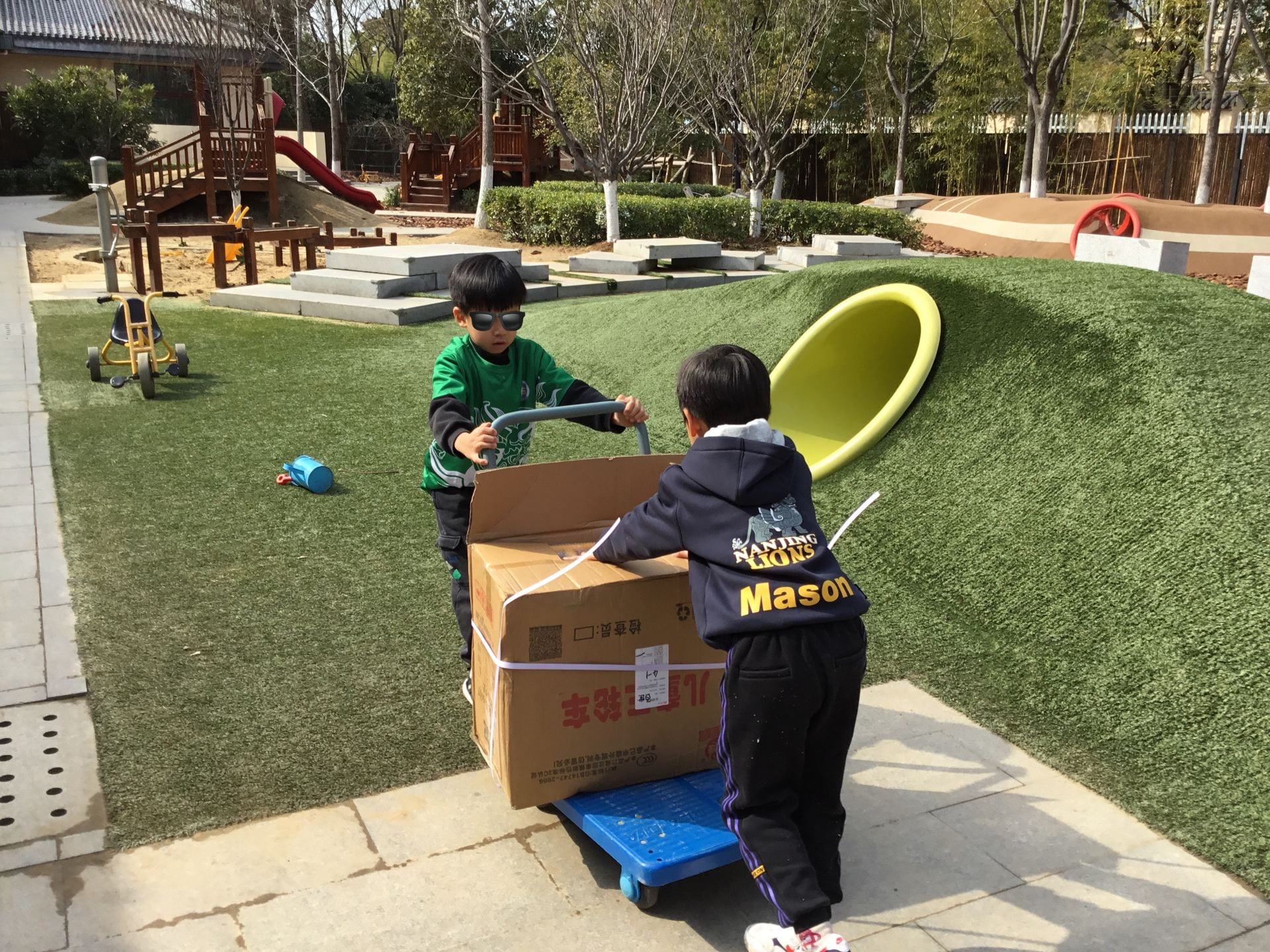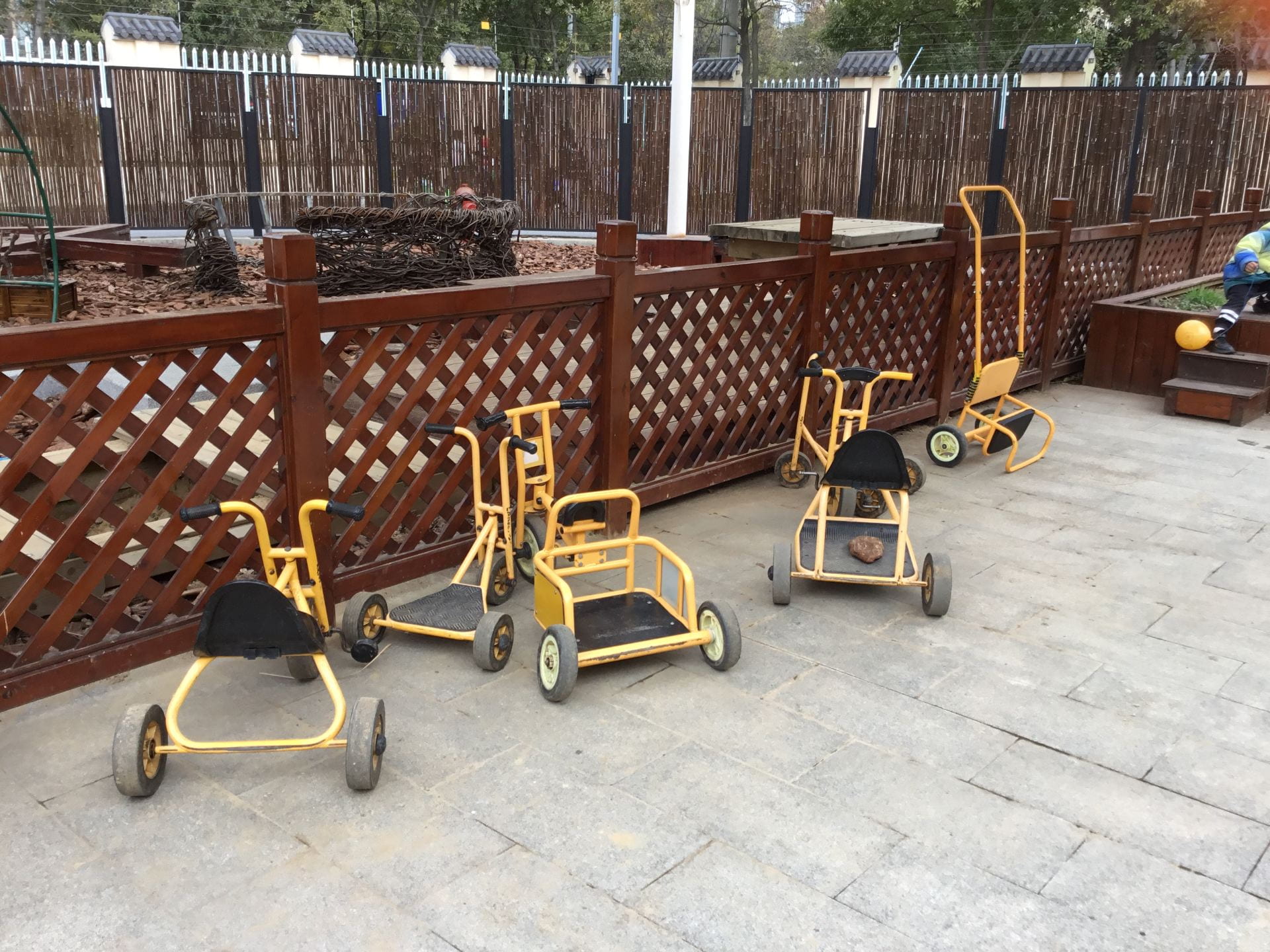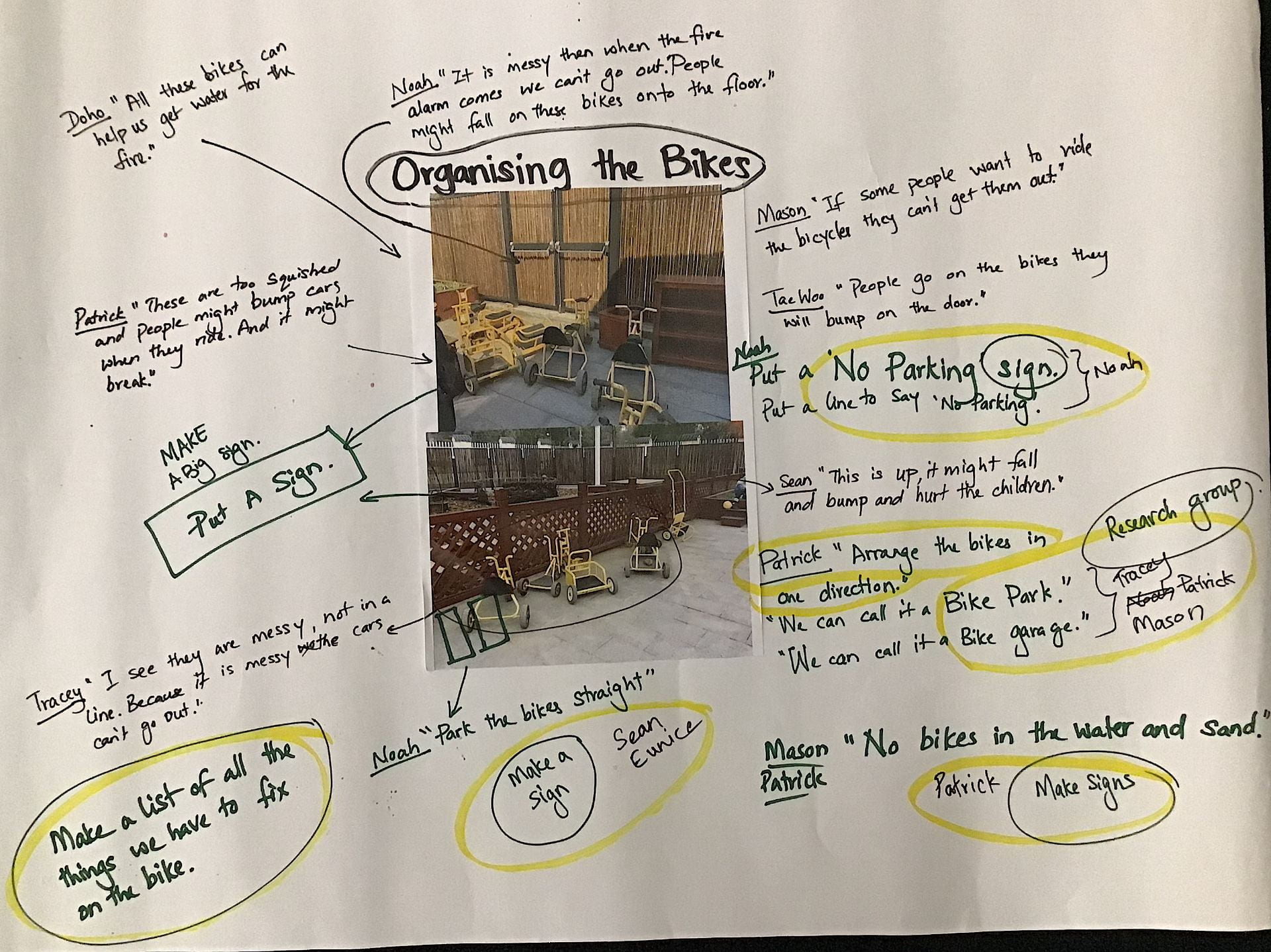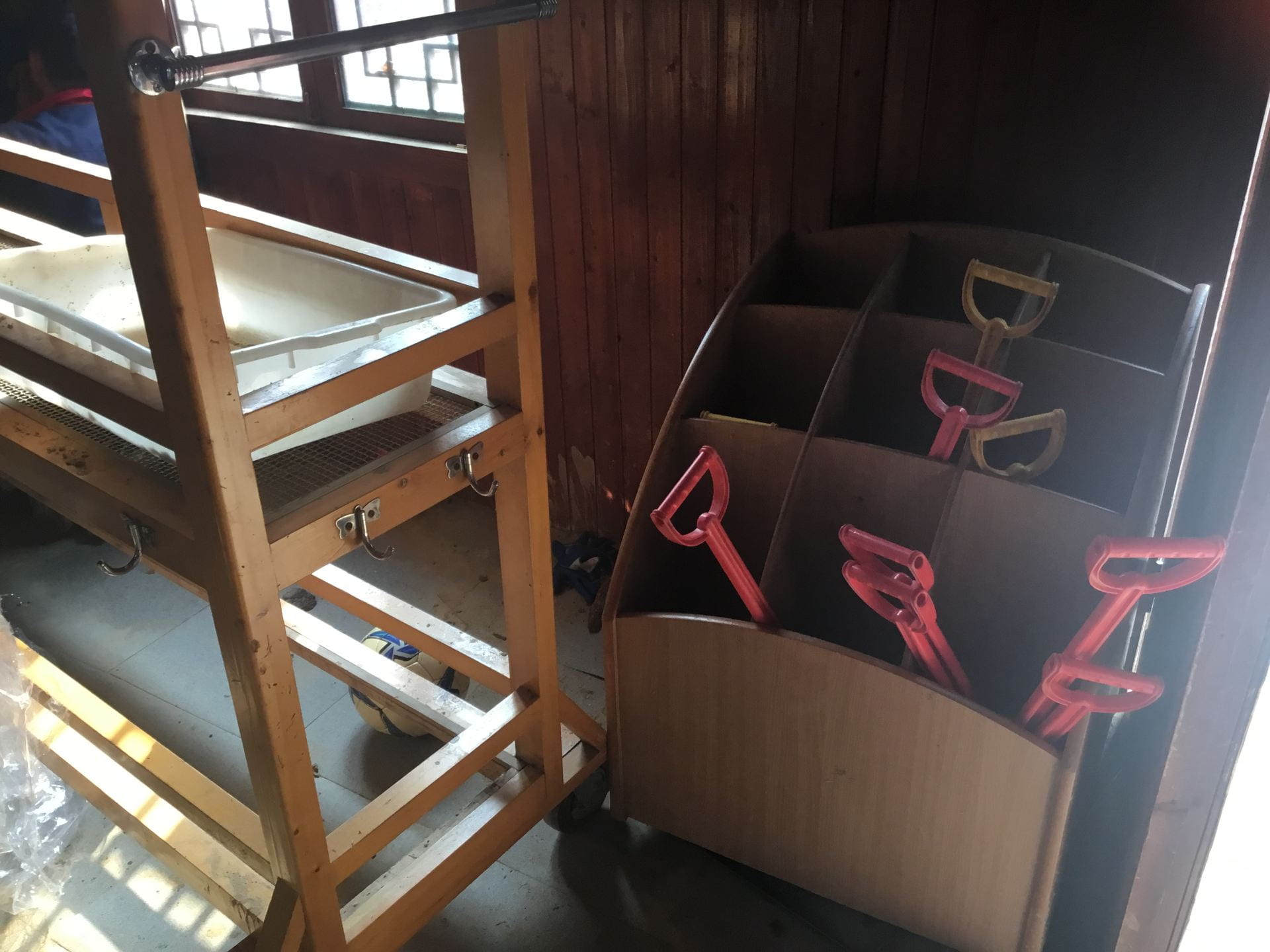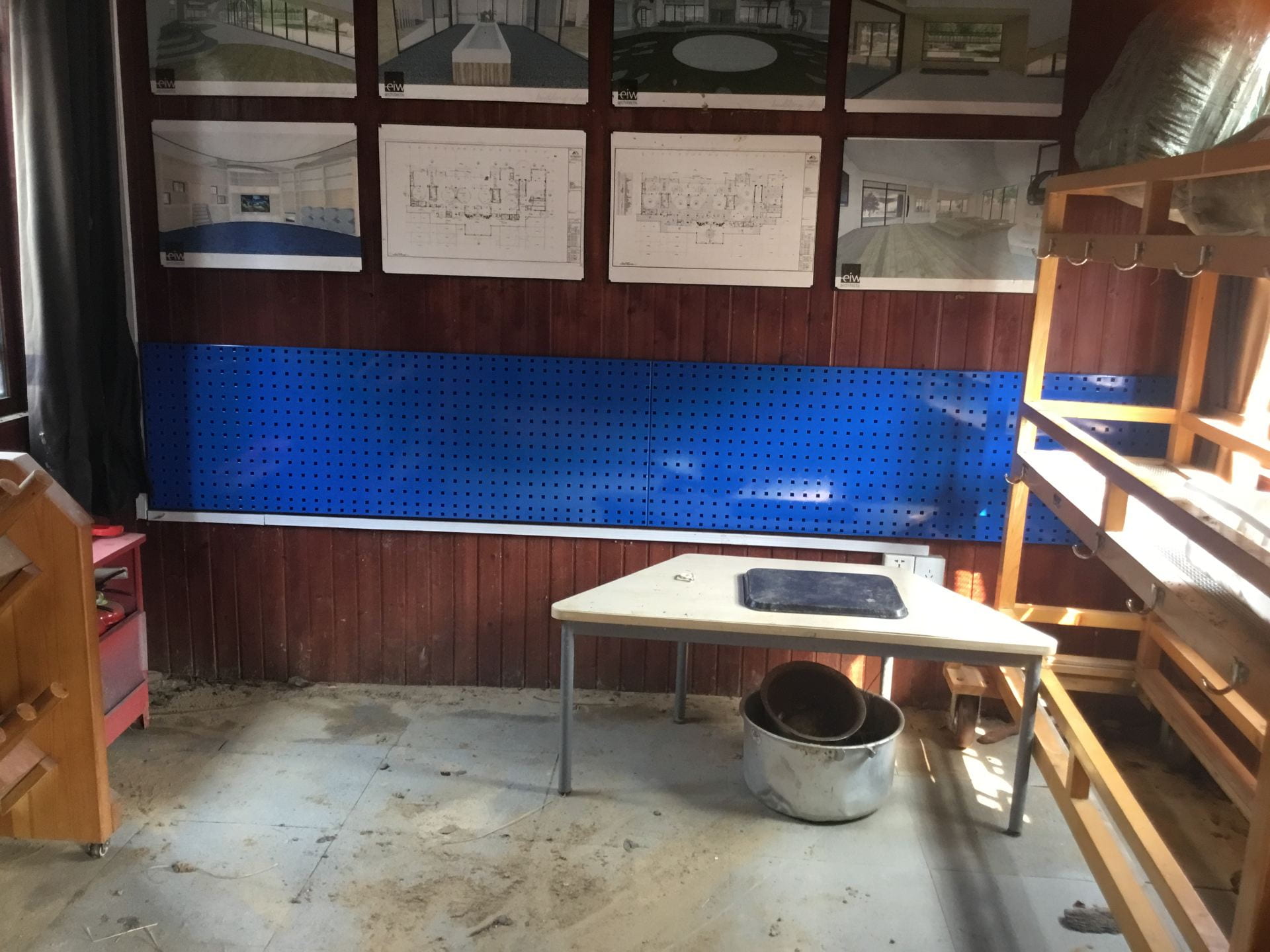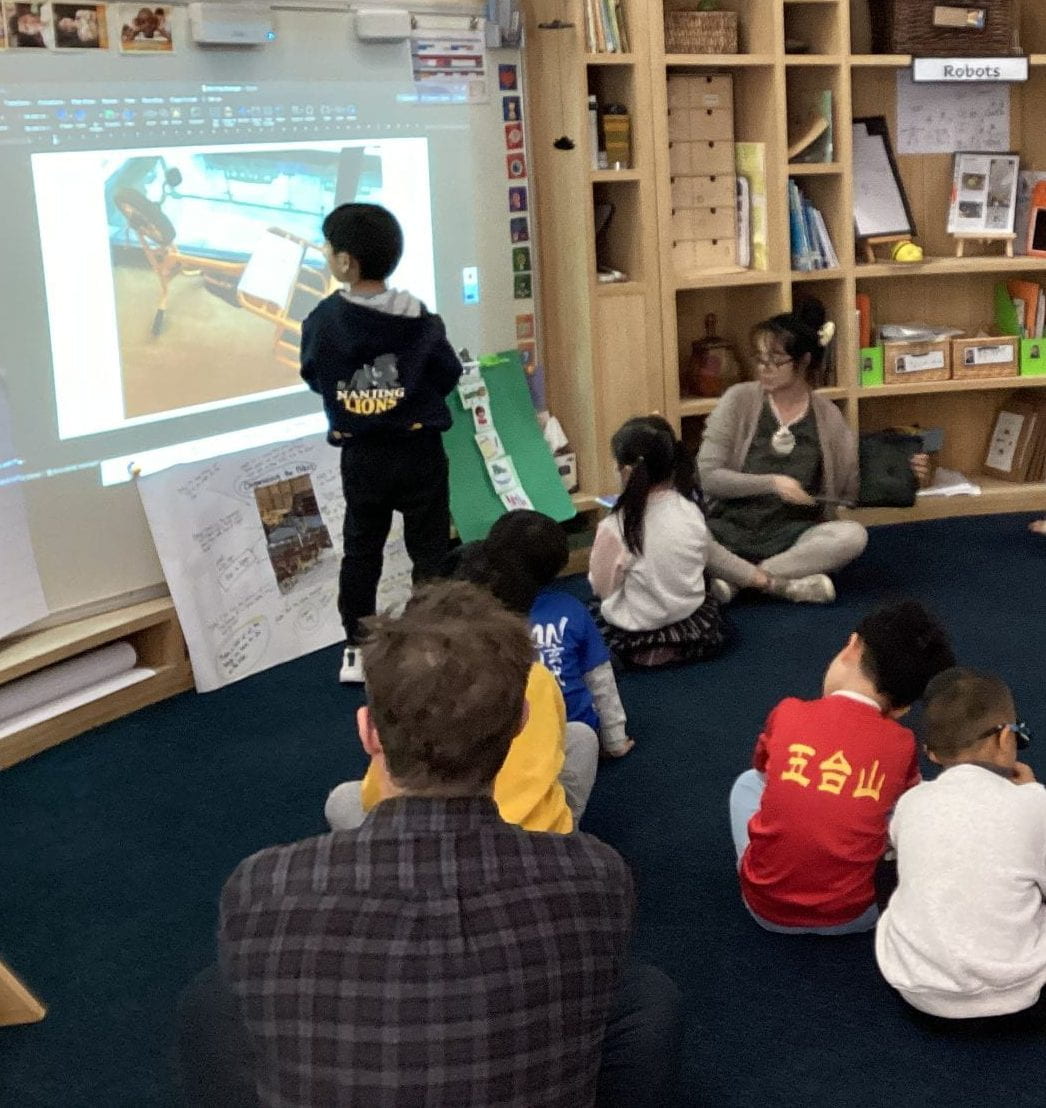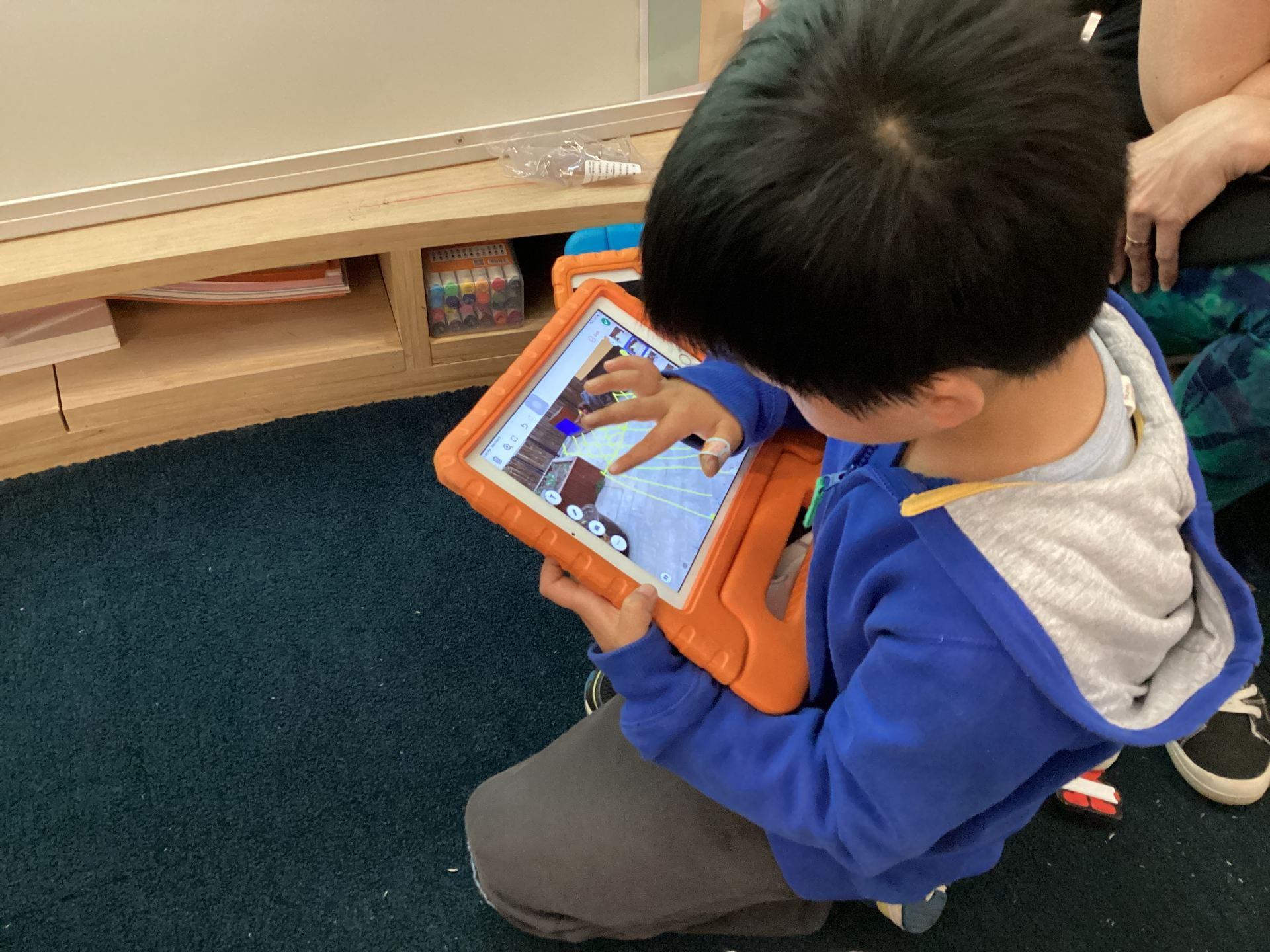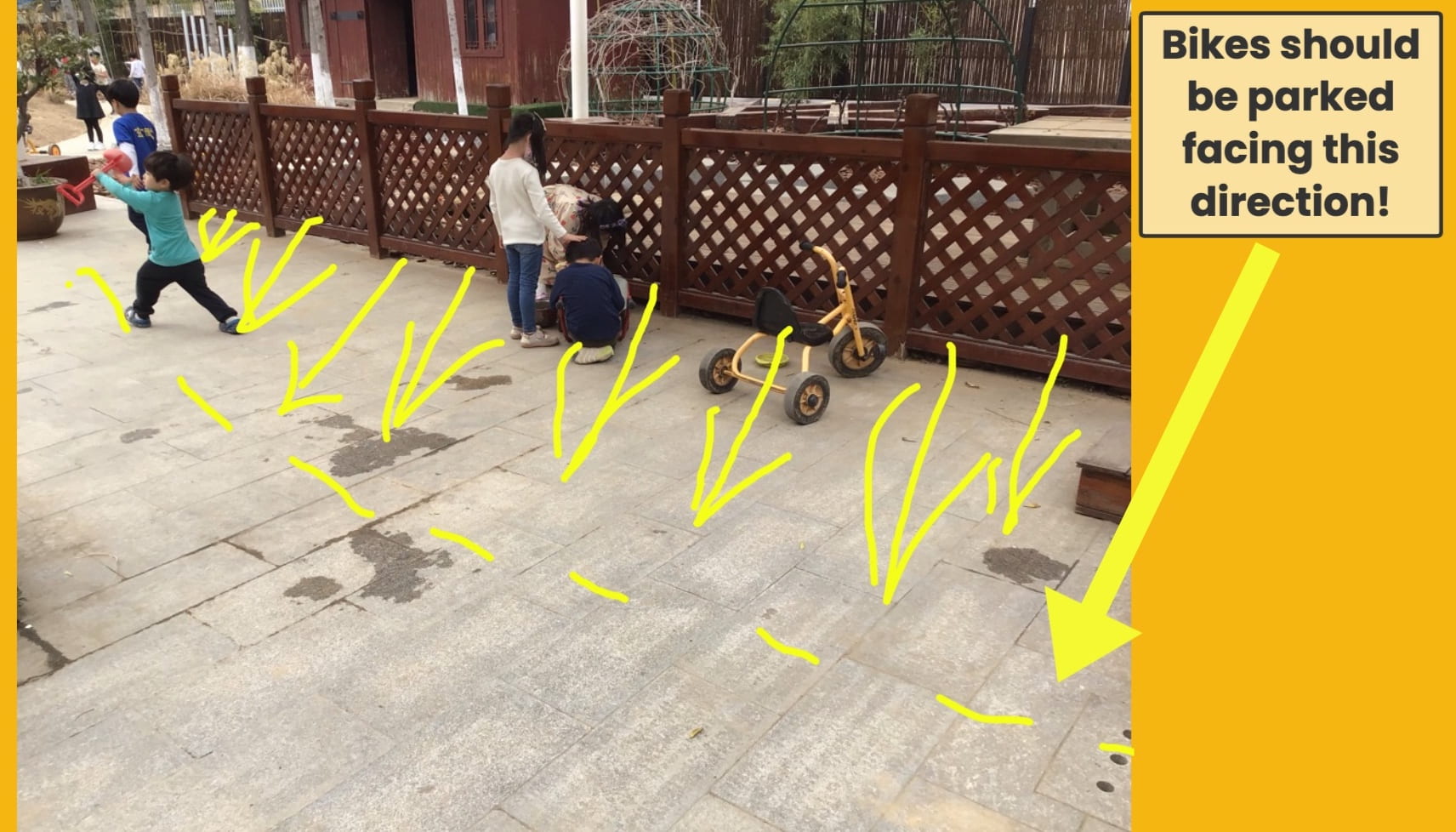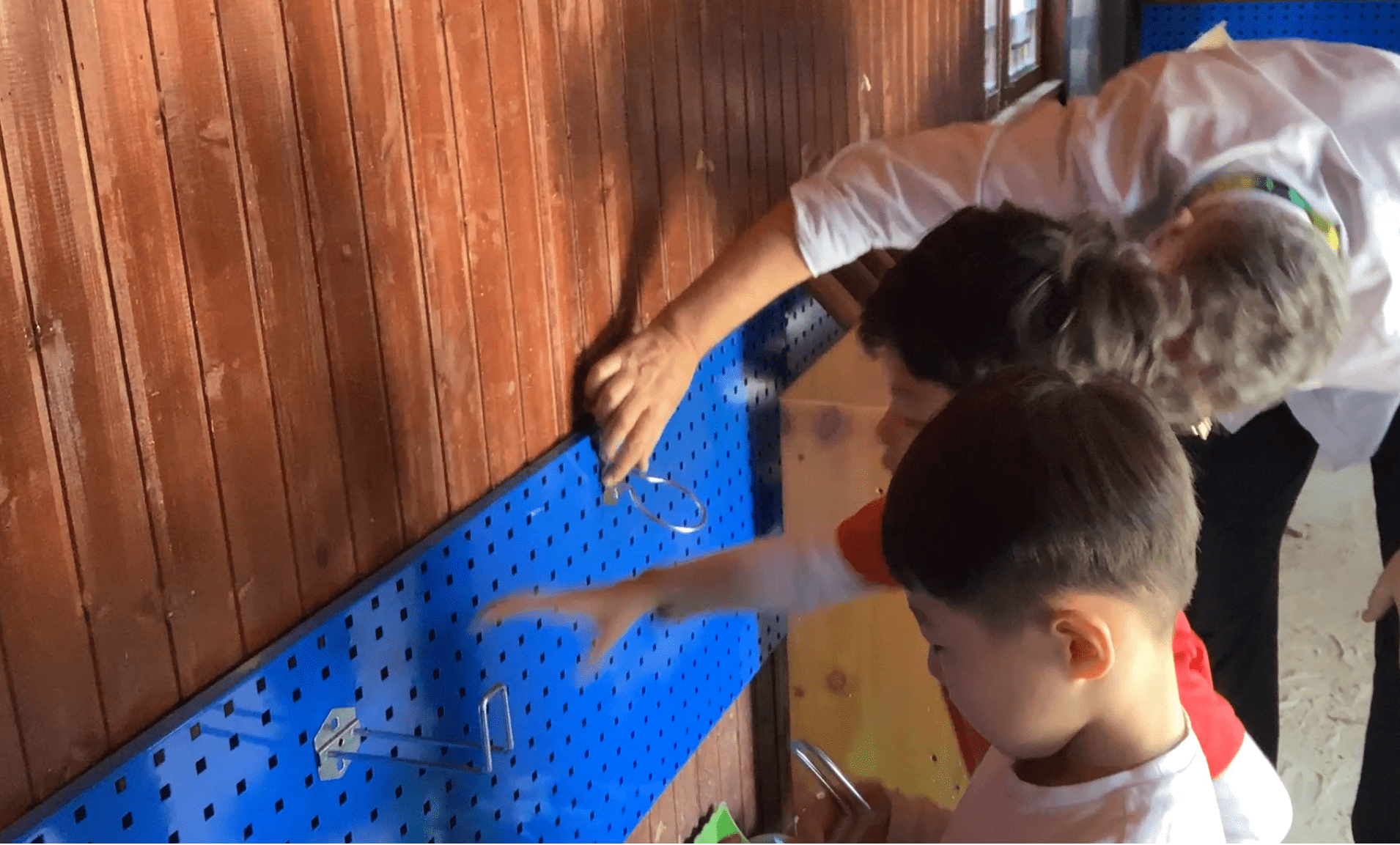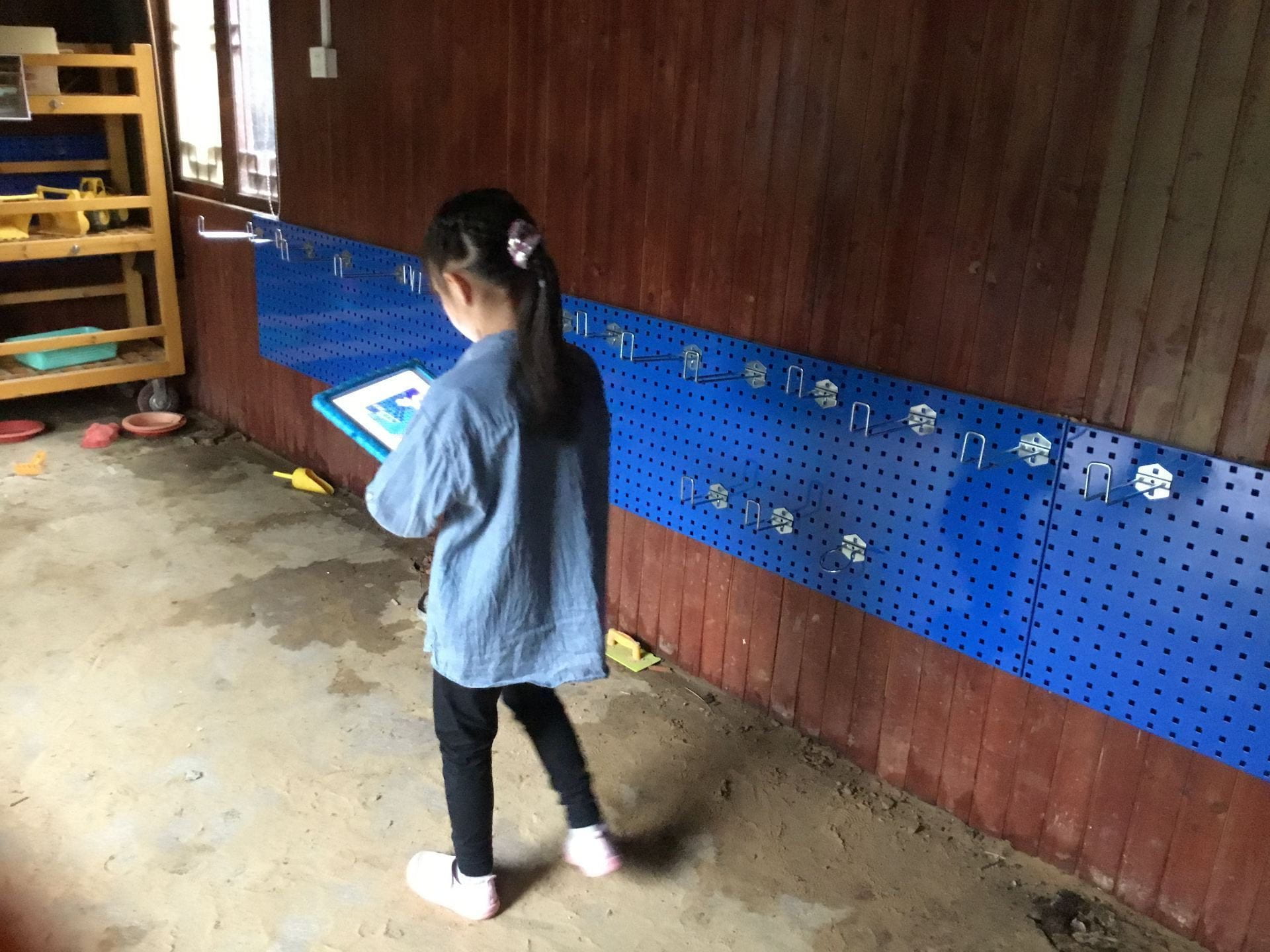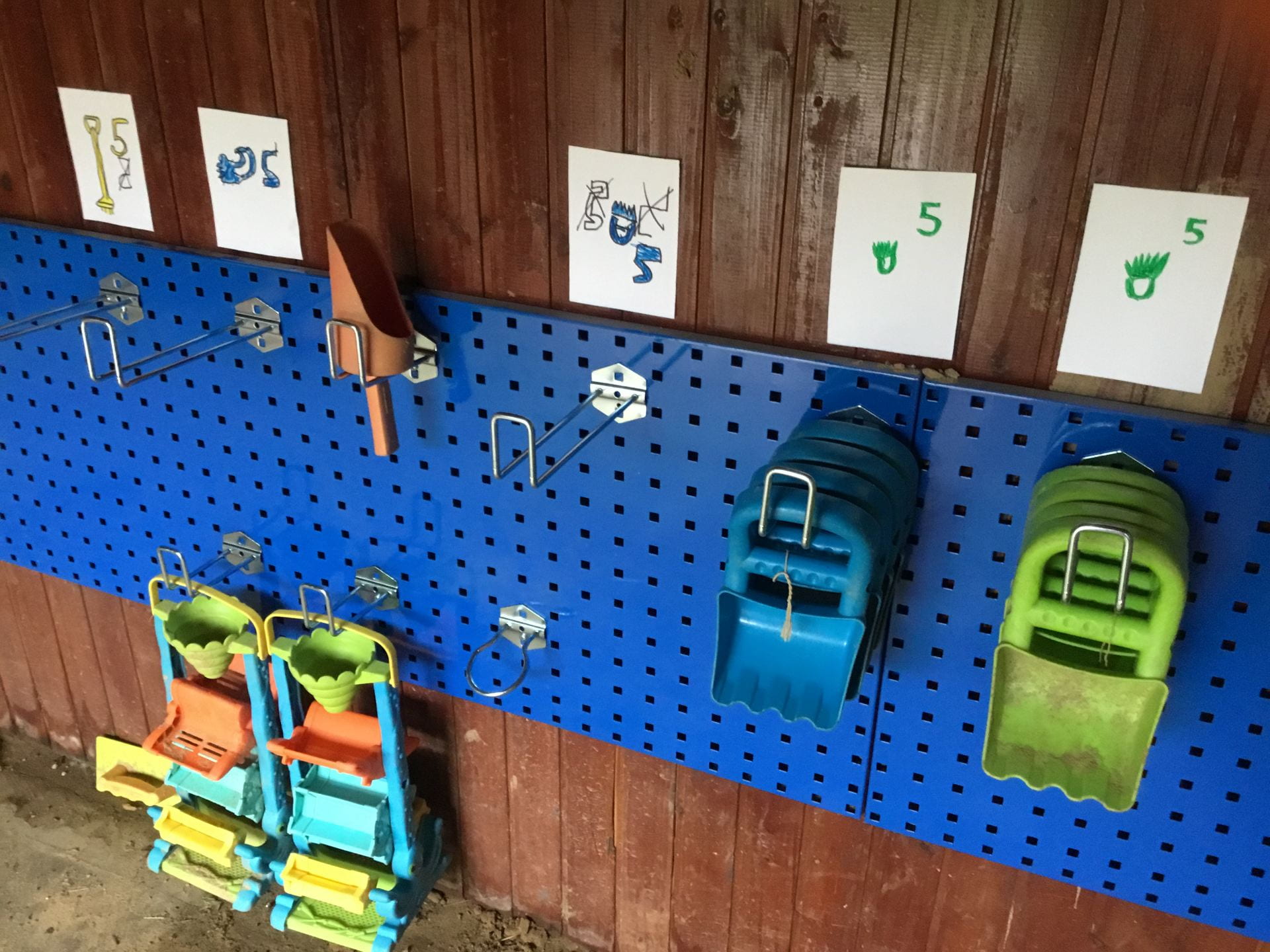How we Organise Ourselves (2022-23)
Central Idea:
Community spaces can bring a sense of purpose and belonging.
Lines of Inquiry:
• the purpose of spaces in our local environment
* responsibilities for shared spaces
* how we organise shared spaces
Key Concepts:
RESPONSIBILITY, FUNCTION
Related Concepts:
resources, needs & wants, systems, oraganisation, initiative, role
Story #1
The Sandpit
We noticed the Support staff clearing out the sandpit. We were curious and decided to investigate. A few of the children who frequently play in the area, building dams and waterways, went out to speak to the staff to inquire about the work being done.
Later, Patrick and Noah shared the photographs with the class and explained the situation to everyone.
- Patrick “We want to make a river and we need water so we put the sand on the waterway. Then there were rocks in the river. They are cleaning the water way and put the rocks on the sand. There is big trouble because the waterway has sand.”
- Noah “Everyone put the sand in the drain because we wanted to make a big river. He (the workers) are cleaning the sand. We are watching how they take out the rocks.”
- Noah “The workers are taking out the rocks. The water is stuck. Don’t put the sand in the pipes because the water cannot go. They were telling not to block the way.”
- Patrick “Ms. Shemo said, this waterway is not clean.”
When it was outdoor playtime, Patrick ran out to the waterway and began to clear out the drain and waterway.
Noah quickly joined in to help. Olivia and Kenan joined in.
 When the water started running down the waterway, they all cheered and squealed with joy!
When the water started running down the waterway, they all cheered and squealed with joy!
When children have agency they reflect on their actions and take ‘action’. They understand that they have an active voice and stake in their classroom and community.
Story #2
The Cave
We often talk about the spaces in our classroom environment, and the different agreements we need to ensure the spaces and materials are used with respect and care.
‘The Cave’ is an elevated space within the classroom. It is one of the children’s favourite learning spaces within the classroom. It is often a space for roleplay and quiet reading. However, over the last few weeks, there has been some tension around the use of ‘the cave’.
 We brought the children together to discuss the issues related to ‘the cave’.
We brought the children together to discuss the issues related to ‘the cave’.
- Why has it been closed?
- What are some of the problems we have had when using the cave?
The children had markers and paper to sketch their thoughts. Then, they shared their ideas with a buddy.
The buddies shared what was discussed. Notes and ideas were documented on chart paper [in black]. We made our thinking and observations visual.
Finally, we decided on how we can solve the problem by creating agreements [in red].
A vote was taken on how many children could be in ‘the cave’ at one time. A decision was made after the children were consulted.
During our discussion and documentation of ideas, problems and possible solutions, we noticed how the children:
- gathered information by listening and interpreting ideas
- listened actively and respectfully to others’ ideas
- recorded observations using drawing and writing
- expressed themselves using words and sentences
- practised empathy and care for others
- were respectful to others
- were aware of their own and others’ impact as members of a learning group
- shared responsibility for decision-making
Story #3
(Responsibility, Ownership)
Three children went out to document a task. What was happening out in the playground? Their responsibility was to observe what was happening, gather the information and inform the rest of the children. There were 4 new garden pots in the Early Years garden. What were they for?
The 3 children observed the activities and used the class iPads to take photographs. They used the photos to create 3 short videos to share their information in English, Korean and Mandarin.
The children shared the videos with the class, informing others about the events. We had 3 plants left. We went outside to decide on our next step.
Noah “I see 3 trees.”
Kenan “Me see 3 trees.”
Tracey “I see some lines on the branches.”
Olivia “I see a box.”
Tracey “But that one don’t have it because we didn’t put.”
We had to decide who would get to put the plants in the boxes. We tried various groups to decide on the right number of people that would work together.
The children made suggestions on the number of children in each group.
- What about 3 in each group?
- Can we do 7 and 7?
- Can we have 6 and 7 and 1?
- Can we have 4 in each group?
This seemed the best number for each group. We had one person left over and she joined one group of 4. Then we were ready to plant.
Ms. Dora helped us put the plants into the boxes. Then, we added more soil to the left-over garden box and planted the 3 plants. Then, we watered the plants.
We sat down to take notes and sketch our thoughts on our notebooks. While drawing, we thought about the questions we had about the plants and the garden boxes.
Patrick “Why are there no leaves on the plants? It is only October, is it too cold?”
Conceptual Understandings:
Living things: Students understand that living things have basic needs, including food and water.
Inquiry Skills
- Pose and respond to questions.
- Participate in guided investigations and make observations using the senses.
- Share observations and ideas.
Story #4
Garden Boxes… continued
A few weeks ago, we potted some plants in garden boxes in the Early Years playground. We gathered to talk about our next steps. The children looked at a picture of the plants and began to make suggestions and share their thinking.
- Tracey “This is the little tree. The little tree is growing up.”
- Patrick “The little tree is growing up, they climb up. It grows up and up here, on the metal bars.”
- Doho “Water in soil and tomato go up and big.”
- Patrick “What seeds is it? I think it is potato seeds.”
- Noah “Ms. Dora helped us.”
Teacher “Yes, she did, but who will take care of them now?”
- Tracey “The helpers. US! We need to put water and the sun will let them grow up. We can do one by one. We can line up.”
- Patrick “4 people helping to water one box. I think Chloe, Sean, Eunice and Doho in one group.”
The children were not sure about this proposal so they continued to share other suggestions.
- Olivia “I have a different idea. My idea is I want to do the little tree. Have water to the tree. Little tree to be a big tree.”
- Tracey “Who is sitting good, they can put the water.”
- Kenan “two people are changing.”
- Olivia refers to the helper of the day chart and suggests “Kenan and Noah go first. Because he is the helper.”
- Noah stands up to explain the plan further and reiterate what Olivia suggested.
- Patrick “Mason and Noah will go tomorrow.”
The children decided that this was the best suggestion, and so a plan was created. They agreed to take turns to water the plants. We heard the children talk about growth and change, and what plants ‘need’ in order to grow. Many of the children were eager to take responsibility to care for the plants while others listened to the debate.
We noticed how the children shared and negotiated ideas. Their suggestions were considered and in the end, they were able to agree on a plan to care for the plants. The children continue to wonder what type of plants they were growing. It was hard to tell as there were no leaves or fruits on the plants.
Our learning continues….
Approaches to Learning (ATL’s)
Research Skills
- Ask or express through play questions that can be researched.
- Use all senses to observe and notice details.
Communication Skills
- Listen actively and respectfully to others’ ideas.
- Participate in conversations.
- Negotiate ideas and knowledge with peers and teachers.
Living things
Students understand that living things have basic needs, including food and water.
Story #5
The Shed Project
(Oraganisation, function of Spaces, Collaboration)
Capable learners know that their voices are heard, and that their ideas and choices can influence their learning projects and the learning environment. With this in mind, we went outside to inspect the playground.
- Tracey “This is the shed. Inside the shed there are toys. We play and then we tidy up.”
- Mason “We can get some things from it. We can play with the sand.”
- Patrick “We can clean the shed and put the materials into the box. In the box there is a basket and sometimes we put the materials in the box.”
- Allen “In the house, we can put the toys that are used for outdoor play. Inside, the toys are broken. Some toys are not really hard so we can’t break them. We need to use it carefully to get the sand.” (in Mandarin)
- Eunice “Inside the shed there are things for cooking like mud and sand and spoons and bowls. Sand and water make the mud.”
- Doho “The shed looks like a house.”
- Kenan “The shed is not clean because some things have mud on it.”
A group of problem solvers went to the shed to inspect it.
Eunice “There are boxes inside.”
Sean “This is a box.”
 There were many boxes in the shed. What was in there?
There were many boxes in the shed. What was in there?
We inspected the boxes to find out.
Tracey “We can use the empty boxes to make things like K2B.”
There were new pinboards in some of the boxes. We don’t know how to make them so we wondered who we could ask. We decided where we would like the pinboards. These boards will help us organise the tools and materials in the shed.
Sean “Put the pinboard here.”
- Kenan “There is a little car, we need to make it.”
- Patrick “My dad always teaches me how to fix things. I can make it. Can we ask Ms. Jo?”
Noah, Patrick, Tracey, Mason and Kenan want to help.
- Tracey “I think it is a new table.”
We wonder if we can find an expert to help us fix the bikes and the shelf.
Mason and Patrick recalled some maintenance staff coming in to fix a broken sink in the Early Years.
- Patrick “They wear the uniform. They can fix it. The uniform is blue and red. I saw them go under the sink and fixing.”
- Mason “I saw it and I tell him it is broken. And he get a tools (a knife). He cut with it.”
When the children were playing outside Ms. Shemo told Mo about the new bikes in the shed.
- Mo “My dad is a design teacher because he can fix things. I can ask him if he can fix the bikes.”
- Ms. Shemo “Could your dad help the children fix the bikes in the shed?”
- Mo “I will ask my dad when he comes to the gym. I will ask if he can help because he knows how to fix the things, that is why he is a design teacher.”
We are excited to see how the EY problem solvers sort out the shed.
Story #6
The Bikes
(Organisation, Collaboration, Function of Spaces)
Kenan saw bikes in boxes in the shed. The group of problem solvers wondered who can help them assemble the new bikes.
Mo asked his dad Mr. Danny if he could help. Mr. Danny agreed and asked Mr. B, the Design teacher to help too.
A group of children went over to the Design room to inspect the space.
Would it be a good space to assemble the bikes?
They met the two teachers and had a look around.
Mr. B had many different tools in the room.
Some were very big and heavy. Mr. B showed the young designers some of the tools that we might need to assemble the bikes. We noticed that the children used measurement vocabulary (big/small/heavy/lighter/long/shorter) to describe the different tools.
They decided that the Design room was a great space to assemble the bikes as it had so many tools and plenty of space to work in. Mr. B suggested that we bring one bike to the Design room to begin the process.
Patrick, Mason and Tracey borrowed a wagon from the Library and used it to transport the box with the bike parts to the Design room.
It was a challenge to steer the wagon, but the team worked together and also had some fun along the way!
The designers in the Early Years will take turn to help with the bike assembly.
We wonder what the new bikes look like.
Are they bigger than the ones we have in the EY playground?
Are they one or two-seater bikes?
Story #7
The Bee Bot Maps
(Function, Systems)
A few weeks ago, the children saw some Bee-Bots in the Design room. They were curious about them and wanted to know how they worked. Tracey and Patrick went to meet Ms. Jo to borrow a Bee-Bot from the Primary Design Room.
Ms. Jo gave them specific instructions on how to use the Bee-Bot.
When they returned to class, they wrote down the instructions and presented them to the class.
Paths and Maps
In the Secondary Design Centre, the children noticed the paths on the floor. They wondered if the paths were for the Lego robot cars.
- Tracey “I think this is for the Bee-Bot.”
- Mason “ I think it is for the new bicycles because I see that line before. The bicycle can ride in there. If you don’t go on the lines you will bump.”
- Eunice “Arrows because car is go to see arrow and go.”
- Patrick “When you go on the arrow you can go on the right (correct) way.
- Kenan “You will bump on the table and on the chair if you go the wrong way.”
- Tracey “We will look at the side and we will touch the Bee-Bot arrow and the Bee-Bot will go.”
We noticed that the Bee-Bots needed directions to help it move.
The teachers knew that the Grade 1 students had also created maps. We went over to take a look at their maps to see what we could learn.
We noticed a picture on the wall.
- Patrick “It can help us know where to go. I have it at home. It can tell us which directions to go.”
- Noah “It’s a map!”
- Kenan “It’s zoo.”
- Tracey “The road is for the Bee-Bot but it’s too small for it.”
- Patrick “Look, a city.”
- Tracey “My idea is we make a big line and let the Bee-Bot go!”
We were inspired. We wondered how we can create our own maps. The children wanted to include roads, a garden with flowers for Bee-Bot to drink nectar and more! The K2 cartographers began to plan their own paths and maps.
They used directional words to explain movement on the maps. Then, we watch how a group of K1 children had created a city a few years ago. We brainstormed new ideas. What more do we need on a map to make travel a safe experience?
The teachers observed the children using arrows to show direction, symbols and signs to share important information, buildings and places to meet the needs of the robots, and labels to help the reader understand key information.
Bee-Bot’s Maps
We look forward to observing how the children use their skills to complete their collaborative project.
Story #8
Organising The Bikes
Two photographs of the bikes in the Early Years playground were presented to the class.
What do you notice?
The children looked carefully at the bikes and shared their observations.
They noticed that:
- The bikes are squished and people might bump into each other when they ride.
- They might break the bikes when they try to get them out.
- The bikes are parked all over, (messy) and it is hard to move the bikes out when needed.
- Some of the accessories for the bikes are not put away safely.
- People can bump into the exit doors because there is no space to ride them.
- The bikes are blocking the fire exit and people might fall over the bikes when trying to get out in a hurry.
The children suggested that we:
- Make big signs to tell people what to do.
- ‘Park the bikes straight’
- ‘NO bikes in the water and sand’
- ‘NO Parking’ sign near the emergency exit.
- Add lines to show the no parking area.
- Make a list of all the things we need to fix on the bikes.
- Conduct a survey to find the most suitable name for the park. The two choices are BIKE PARK and BIKE GARAGE.
Next Steps…
Story #9
Pinboards for the Shed
(Organization, function, systems)
A few weeks ago, a group of children went into the shed to try and organise the space. They noticed that the spades, sand toys and kitchen items were left all over the shed. We decided to try and organise it.
We ordered some pinboards but they needed to be mounted on the walls.
The children decided where the pinboards should be mounted.
Ms. Hannah sent the information to the maintenance staff department.
When the maintenance staff arrived, they opened the boxes. The pinboards were blue! We saw some screws in the box.
The maintenance staff thought about the children’s request. There were more pinboards than we had planned to have but the team shared some good suggestions. They began to mount the boards in the shed.
Now we have new pinboards to organize the tools and toys.
Our next step is ‘to discuss and agree on how we might organize the space so that people can use the different items safely’.
We continue to see the children taking ownership over their spaces, observing, discussing and creating functional spaces that meet their needs. The children know they have a voice, and that their ideas and creative thinking can lead to positive changes that support the community. Through these experiences they explore how community spaces can bring a sense of purpose and belonging.
Story #10
Fixing the Tricycles
We held a class meeting to talk about our nest steps with the Bike Project.
Mr. Danny and Mr. B joined our meeting and took note of the problems the children shared about the older bikes in the playground.
- The front wheels are wobbly.
- Some bikes don’t have the pedals.
- Some bikes don’t have the rubber sleeves on the handles.
- The seats are moving around.
- The back tyres are wobbly.
- Some of the screws at the bottom of the trikes are not tight enough.
A team went back to the design room to bring the tools they needed. They were HEAVY!
 Then, the expert mechanics got to work with their eager assistants, tightening nuts and bolts, fixing the wobbly seats and adjusting the wobbly wheels.
Then, the expert mechanics got to work with their eager assistants, tightening nuts and bolts, fixing the wobbly seats and adjusting the wobbly wheels. 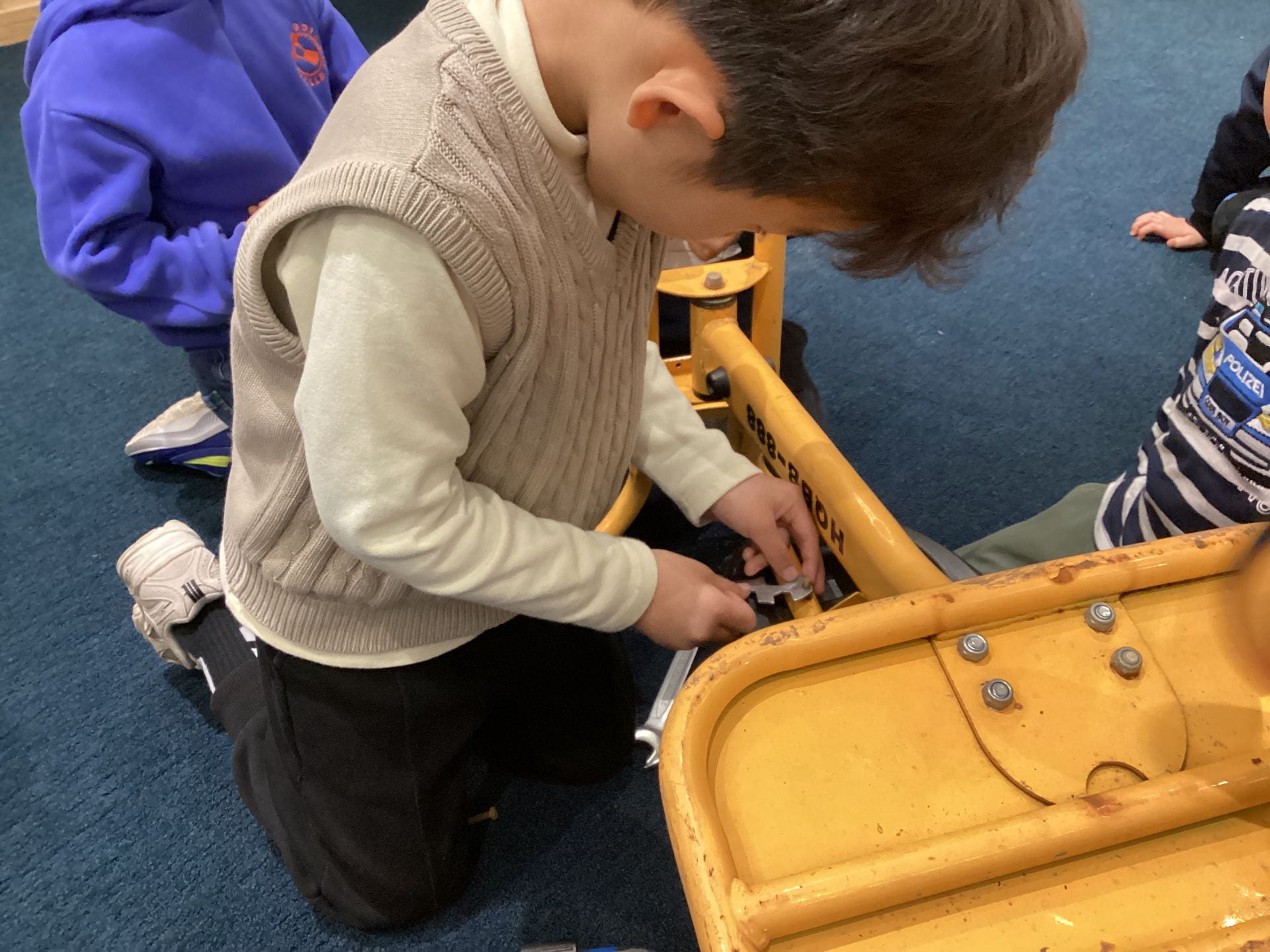

The mechanics took the bike for a test run to see if there were any more problems that needed their attention. The ride was smooth!
Story #11
The Bike Project – Research Groups
Our Bike project continues, with children leading research projects to help them make the best decisions for their outdoor space.
Name for the Parking Spot: Conducting a Survey
from our brainstorm on the different A group of mathematicians interviewed the Early Years community to find out their preference for the name of the parking spot. The two choices were BIKE PARK or BIKE GARAGE.
The team used tally marks to record the data on the survey.
Then they worked together to calculate the total for each choice.
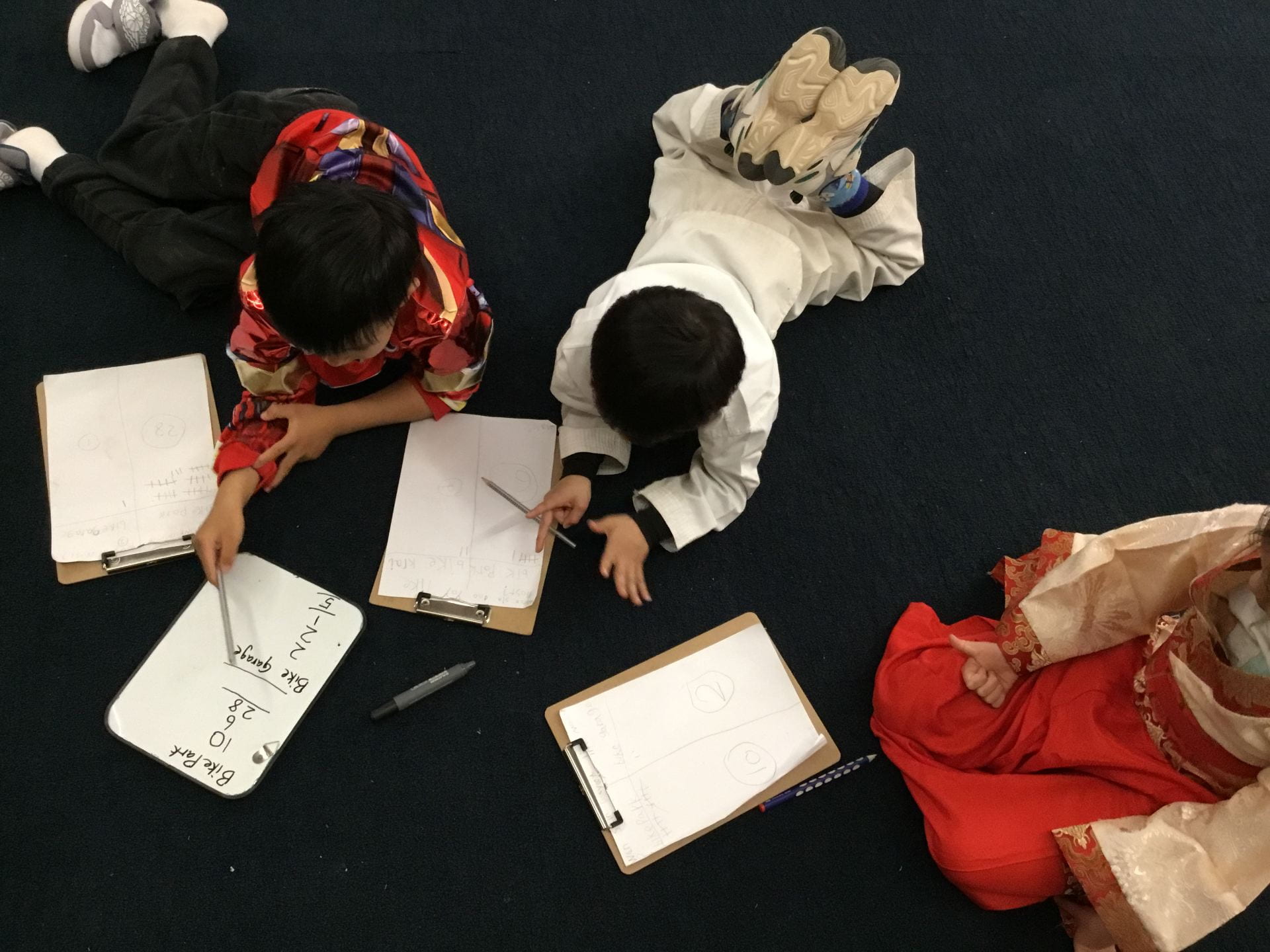
 Through their research they learned that more people preferred the name ‘BIKE PARK’!
Through their research they learned that more people preferred the name ‘BIKE PARK’!
NO PARKING area: Field Visit
The children wanted to find a way to create a ‘No Parking’ area near the emergency exit. We know the school has many NO PARKING areas and areas where you can park. Noah went on a field visit to learn more.
- What do we notice in the parking spaces?
- How is the space organised?
Noah created a video to share what he learned from his research. We wonder how we might use these ideas to help us organise the tricycle park.
Signs and Messages:
Another team of researchers brainstormed ideas for the signs. They began by looking for signs around the Early Years Centre.
- What materials are signs made of?
- How are colours, shapes and words used to share messages?
- What messages and actions do they communicate to people?
They used the iPads to record their observations and brought photographs back to the team.
The researchers discussed their observations while Ms. Eileen documented key points on chart paper.
The team decided that ‘plastic’ would not be an appropriate material to use as they didn’t know how to make plastic.
 They didn’t want to buy plastic from the shop as it was their own project. They wanted to make the sign all by themselves.
They didn’t want to buy plastic from the shop as it was their own project. They wanted to make the sign all by themselves.
‘Paper’ and ‘card’ were not the best materials for the signs as it breaks and tears easily.
Although card is stronger, it will get wet when it rains as the signs will be outdoors.
Yet another choice were ‘stickers’. They may last longer and are waterproof, but they might come off after a while.
 The team decided that stickers were not a suitable choice either.
The team decided that stickers were not a suitable choice either.
They noticed that the ‘wood’ was very strong and wouldn’t rip. If they used thicker wood, it would make the sign stronger.
 The team decided that wood would be the perfect material for the signs.
The team decided that wood would be the perfect material for the signs.
They wondered if someone used stone to carve the wood, or fire to draw the sign. They decided that their next step would be to meet Ms. Jo and Mr. Danny to ask them more about the sign. Other ideas the team would consider:
- How big does the sign need to be?
- Where will the sign be placed?
- How will it be fitted safely?
The team wondered how they might use what they have learned about traffic rules, signs and important messages in their own planning.
We look forward to our next steps as we begin to use what we have learned to organise the ‘BIKE PARK’.
Tricycle Agreements:
The children have been discussing the ‘Bike Park’ and making plans to change the space, to make it more organized and safe. Hearing the children’s ideas on what we ‘should NOT’ do with the bikes, we decided to invite them to think about what we ‘CAN do’ instead.
The children put their ideas on paper, using drawings, words, sentences and discussion to express their thinking.
Then, we put all the ideas down on one chart paper.
In the next few days, the children will present these ideas to the rest of the Early Years classes and decide if changes need to be made to these agreements. Through this experience, we noticed how the children:
- documented and shared ideas using drawing, emergent writing and annotating images
- listened actively and respectfully to others’ ideas
- participated in conversations
- shared responsibility for decision-making
The Bike Park Plan
The teachers set up a time lapse video after playtime to provoke the children’s thinking. We watched the video during our class meeting and discussed what we noticed.
We reflected on what Noah had said about blocking the emergency entrance. We also noticed how Kenan and Noah parked the bikes, making sure they are parked in reverse.
Noah used the iPad to show the class how we could keep the walkways in the playground clear of tricycles.
 He thought about what he had learned through his research about the school parking lots, and then used the iPad to show how the lines could be marked on the floor. The yellow lines would be a ‘NO PARKING’ area. The class gave him feedback as he made the plan.
He thought about what he had learned through his research about the school parking lots, and then used the iPad to show how the lines could be marked on the floor. The yellow lines would be a ‘NO PARKING’ area. The class gave him feedback as he made the plan.
The messages and signs team are ready to begin their work on the signs to help the EY community know how to park the bikes.
Another team will present their ideas to the facilities department and relevant personnel in school, to help them make the changes they need. They will need to convince the facilities team that their suggestions will ensure we have a safe and organised playground.
Story #12
The Shed Project – organising the space
Sean, Kenan, Eunice and Doho have been leading in the ‘Shed Project’. They sat down to decide their next steps.
- Teacher “The maintenance staff have fixed the pinboards. What do we need to do next?”
- Kenan “We need to put a thing like a peg on the pinboard.”
- Sean “What is a hook?”
We looked at some different types of pegboard hooks.
- Kenan “We need to put the hooks because there are too many things.”
- Sean “So dirty. Floor is sand. Some people play with sand and throw the sand.”
- Eunice explained that the sand needs to be “outside in the sandbox.”
- Doho “Some children put the sand inside. And some children mess it together.”
- Eunice “Making the things dirty.”
- Kenan “We need to put the sand back in the boxes. The sand needs to be in the EY Playground.”
- Doho “Don’t put the sand inside the shed. Play in the sandbox. We need to clean the floor and put the sand back into the box.”
- Kenan “We need to put the shovels on the pegboards.”
- Sean “Pans and play cooking things, hang them up on the pegboards.”
- Doho “NO putting things on the floor!”
- Kenan “We need to put a sign.”
- Eunice “Some person is making messy cooking. Don’t make a mess. Go to the sandpit and play.”
- Doho “Some children making cooking and throw the sand inside.”
- Sean “Put the trucks on the racks.”
The team drew pictures to share their thinking.
The team presented their ideas to the class and asked for other suggestions to make the space better.
Kenan “We need to put the spades on the pegboard.”
Questions and Answers:
Patrick “Why are the shovels on the pinboard.”
Kenan “Because there are so many shovels. We can use the pinboards.
Patrick “But I did not see the shovels on the floor. Can we put 2 shovels in one hole.”
We might think about the different ways we can organise the shovels.
Sean “Put the trucks on the racks.”
Questions and Answers:
Tracey “Why do not have new toys? Why are there racks on two sides?”
Sean “There are many cars.”
We might need to think about purchasing some new toys.
Eunice “We need to put the sand toys on the rack.”
Questions and Answers:
Tracey “Why is the sand on the floor?”
Eunice “She gets it and puts it on the floor.”
Tracey “Why did she throw the sand out and put it on the floor and the clothes?”
Eunice “She did not throw, she is playing.”
Doho “We need to cleanup inside the shed.”
Doho explained his drawing and answered questions about the shed, the sand on the floor and the shelves on the side wall that will be used to store more toys.
The team will consider the ideas suggested by the class. They would like to propose their suggestions for improvement to Ms. Jacqui to plan their next steps.
Story #13
Proposals to Ms. Jacqui
Different teams have been working together to make changes to the Early Years Playground. They have been conducting their research to look for ways to organise the play areas to make them safe and functional.
The ‘Shed Project’ team had received samples of the hooks for the pegboards.
 They checked the height of the pegboards and tested the hooks to see which ones were most suitable.
They checked the height of the pegboards and tested the hooks to see which ones were most suitable.
Doho, Sean, Kenan and Eunice were ready to share what they leaned. They presented their ideas to the class and Ms. Jacqui.
Kenan liked all the hooks but decided that the circular ones were the least useful as they were too big and the tools fell through them.
Doho, Sean and Eunice also preferred the long straight hooks as you could hang more tools on them.
Ms. Jacqui was very happy to see the curved edges on the hooks as they were safer for the children.
We noticed that the children used a range of mathematical vocabulary; bigger, longer, shorter, to express their ideas about measurement.
The class gave them some feedback on the different ways the toys could be hung up.
Ms. Jacqui “How many tools do we have and how many hooks will we need? We don’t want to buy too many, we just want to get what we need.”
- Tracey “We can count them!”
Tracey explained that the pegboards could not be mounted higher as the younger children have to be able to reach the tools.
Next, the team will work together to decide how many hooks we need to order for the shed. Then, they will need to put in a purchase order to buy the hooks. Ms. Jacqui suggested that they ask Mr. Jamie, the Grade 4 teacher to help them attach the hooks as he has a drill.
Next, we presented the proposal for the ‘Bike Park’. The children explained the reason for the yellow lines on the floor. We asked Ms. Jacqui if we can paint the floor. Ms. Jacqui agreed that the emergency exits, and walkway should always be clear.
Ms. Jacqui thought about the idea of painting the ground. She wondered if there were other ways to let people know that it was a ‘NO PARKING’ area.
- Kenan “We can put a ‘NO Parking’ sign!”.
- Mason “Put and red X on the floor!”
These were all great suggestions.
Next, the children explained the arrows in the parking area. They worked hard to convince Ms. Jacqui that their proposals will help the riders park and ride the bikes safely and quickly.
Ms. Jacqui “Instead of just painting it right away, what else can we try first?”
- Tracey “We can put a sticker!, We can test it first!”
The children had many different ideas to communicate the message. We will begin to ‘test’ some of the suggestions to see how they work before asking for the floor to be painted.
We noticed how the children shared their thinking, providing examples to convince others of their ideas. We noticed the children listening to each other, building on each other’s ideas to find ways to solve problems and look for the best solutions. We look forward to our next steps in making the Early Years Playground more exciting, organised and safe.
Story #14
Sorting and Data Collection
A team of children went to the shed to begin sorting the toys. They placed tubs for the sand toys, put the kitchen and cooking items on one rack and all the trucks and diggers on the shelves.
Next, Doho and Sean went to look for Mr. Jamie, to ask him if he could help the team mount the hooks on the pegboards.
Sean and Doho explained the problems they had, and then they went out to the shed with Mr. Jamie. Together, they were able to problem-solve and make a plan to mount the hooks.
A team of K2 mathematicians went to the shed to gather more information to plan the next step of the project. We needed to find out how many hooks, tubs and racks we will need to sort and organise the different toys in the shed.
The team began to think about the different ways we can record data. We decided to divide the paper into four to record the number of kitchen items wheelbarrows trucks and sand toys.
Then, the data collectors used pictures, words and numbers to record their information.
We observed the children:
- gathering, recording and organizing information
- listening actively and respectfully to others’ ideas and listening to information
- using mark-marking to convey meaning
- taking responsibility with tasks
- using strategies to problem-solve
Story #15
The Shed Project – Installing the Hooks
Over the past few months, we have been planning and organising the Shed.
After a planning meeting with Ms. Jacqui, the project team decided to order hooks for the pinboards in the shed. After their data collection, they placed an order for the hooks.
The hooks for the shed arrived through the post. The team worked to attach them to the pinboards.
Another team went to the shed to count the number of hooks and signs we need. They recorded their information on the iPad.
Then, created labels with images and numbers to let the children know how to sort and store the different items in the shed.
While planning and organising ‘The Shed’, the children took responsibility and ownership of their learning spaces and materials.
They worked in teams, sharing ideas, listening to different perspectives and working together for a purpose. They used their thinking skills to explore possibilities, to reimagine spaces and solve problems in creative ways.
The children used their knowledge of number and data handling when collecting and sorting information. Discussing and presenting ideas, documenting their learning and using what they know about signs and labels to inform others, developed their literacy skills.
Story #16
The New Nest Design
Following on from our last meeting about the nest where we gave Ms. Jacqui suggestions for the design, Mr. Arek and his team presented a first draft design of the nest to the children in the Early Years. We gathered to discuss the design and give Mr. Arek some feedback and suggestions for consideration.
What we like…
- Doho “We can see the flowers. The colours are good and have flowers and the nest has a chair. And grass because the flowers can grow up.”
- Tracey “The nest is beautiful because it’s clean.”
- Kenan “The nest is good. We can have a picnic.”
- Joon “The nest is like a rainbow.”
- Sanghyeok “Have a desk and the flowers, this is good.”
- Sean “The flowers are good and we can sit down and eat the snack because there are chairs. And we can draw.”
Everyone likes the flowers on the table.
Everyone likes the flowers around the bench.
Everyone likes to have the table.
Suggestions
- Mason “I think we need to make the nest bigger. And we can have a picnic in it and have some water to drink in it.
- Allen “I like the inside because the floor is flat. We don’t like the wood chips because its bumpy and it makes us fall down.
Wonderings
- Eunice “Can we have a bird house?”
- Sanghyeok “Can we have small animals in there, like birds and butterflies?
- Mason Can we have a bed in the nest then somebody can sleep in it? Can we make a bigger nest?” Can we have a door? Can we put grass on the floor?
- Allen Can we put the picnic mat? Can we make it bigger?”
- Noah “How does the bench part stand up when there are no legs?”
- Tracey “Why is it a rainbow inside?”
- Sanghyeok “Why are there flowers on the table?”
- Eunice “Can we have cushions on the bench?”



